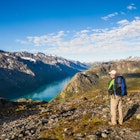
Aug 21, 2025 • 11 min read
Abundant seafood, regional specialties, and cutting-edge cooking using hyperlocal, seasonal ingredients make eating in Norway a locavore’s delight.

Aug 21, 2025 • 11 min read
Abundant seafood, regional specialties, and cutting-edge cooking using hyperlocal, seasonal ingredients make eating in Norway a locavore’s delight.

Jun 19, 2025 • 6 min read
Both Nordic countries are objects of worldwide fascination. We asked a pair of expert writers to make the case for why their pick has the edge.

Apr 9, 2025 • 10 min read
Always dreamed of seeing the aurora borealis? Here’s our guide on how and where to see the northern lights.

Feb 10, 2025 • 11 min read
For an unforgettable road trip through some of Europe’s most remote and breathtaking scenery, follow this week-long itinerary through Arctic Norway.

Oct 3, 2024 • 5 min read
See the northern lights and much more in the Arctic regions of Sweden, Norway and Finland. Here are our top tips.

Sep 27, 2024 • 6 min read
Destination Editor Melissa Yeager shares an alternative, eco-friendly option for experiencing the wonder of the Norwegian landscape from the sea.

Mar 21, 2024 • 6 min read
Norwegians go the extra mile to welcome travelers with children in tow. And the country’s natural attractions are delightful no matter your age.

Mar 20, 2024 • 4 min read
Deciding to go to Norway is easy, but figuring out the entry regulations can be tricky. We've gathered all the info to help you on your way.

Mar 20, 2024 • 8 min read
How to stretch your budget without missing out on the fantastic experiences that Norway has to offer.

Mar 19, 2024 • 9 min read
The best way to take in Norway’s epic landscapes? Behind the wheel of a car. Here are five top road trips for experiencing it all.

Mar 18, 2024 • 5 min read
Whether you want the midnight sun or the northern lights, our guide to when to visit Norway in 2024 gives you the details you need to book that trip.

Mar 18, 2024 • 6 min read
Norway is a wonderful destination – beautiful, safe and welcoming. However, these are the insider tips that will make your trip easier and cheaper.

Mar 14, 2024 • 7 min read
Norway's appeal is remarkably simple: this is one of the most beautiful countries on earth. Here are the must-visit places on your trip to Norway.

Mar 12, 2024 • 7 min read
From cruising the fjords and wild camping to cities full of culture and incredible food, here are 13 top things to do on a visit to Norway.

Mar 10, 2024 • 5 min read
Norway has efficient and comfortable public transport but its challenging landscape can make for tricky journeys. Here's how to get around Norway.

Aug 16, 2022 • 5 min read
Experience the best of Norway's coastline and rethink what it means to take a beach vacation.

Aug 16, 2022 • 11 min read
From mountains where wild reindeer roam to rock formations with giddying fjord views, here are the best hiking routes in Norway.

Jan 10, 2022 • 8 min read
Norway’s incredible landscapes have inspired myth and legend for generations.

Jan 10, 2022 • 9 min read
In the home of Indigenous Sámi in Norway: hear traditional Sámi song, see reindeer and chase the Northern Lights.

Jan 10, 2022 • 6 min read
Wind through the wilds of Norway's western coast on this epic road trip.

Oct 26, 2021 • 5 min read
The northern lights if you're lucky, an ice hotel if you're brave: Norway's Far North is a premier Arctic playground.

Sep 21, 2021 • 10 min read
From sapphire-blue fjords to the glacier-capped wilderness of the Arctic, nature in Norway is off the scale. Here's a guide to Norway's top national parks.